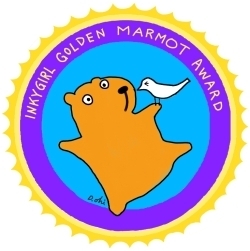Debbie Ridpath Ohi's Blog, page 95
June 10, 2013
Picture Book Writing Process: How Hélène Boudreau Wrote I DARE YOU NOT TO YAWN (Candlewick Press)
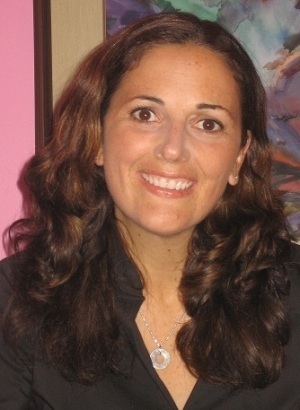 I met Hélène Boudreau through Torkidlit, and have continued to be impressed by this woman's energy and enthusiasm for kidlit/YA online and offline. I interviewed Hélène a couple of years ago about her book, REAL MERMAIDS DON'T WEAR TOE RINGS, and am delighted to be interviewing her again about her picture book, I DARE YOU NOT TO YAWN.
I met Hélène Boudreau through Torkidlit, and have continued to be impressed by this woman's energy and enthusiasm for kidlit/YA online and offline. I interviewed Hélène a couple of years ago about her book, REAL MERMAIDS DON'T WEAR TOE RINGS, and am delighted to be interviewing her again about her picture book, I DARE YOU NOT TO YAWN.
The book just recently came out from Candlewick, and has hugely adorable illustrations by the French artist, Serge Bloch.
Hélène is an Acadian/Métis writer and artist. A native of Isle Madame, Nova Scotia, she writes fiction and non-fiction for children and young adults from her land-locked home in Markham, Ontario, Canada. She has published five non-fiction and nine fiction books for children and young adults, including the picture book I DARE YOU NOT TO YAWN (Candlewick) and the tween series REAL MERMAIDS (Sourcebooks/Jabberwocky).
You can find more info about Hélène at her website, on Twitter, Facebook and Goodreads.

Q. What is your writing process?
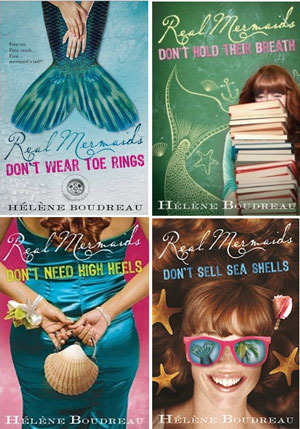 People are often surprised when I tell them it took me three times longer to write and revise my 400-word picture book, I Dare You Not to Yawn compared to my 50,000 word novels from my Real Mermaids tween series but it is absolutely true. That said, the process for creating both is quite similar. When I speak to school groups about my writing process, I do it in terms of the ABC’s of writing. Of course, it’s not as simple as that sounds but it’s really all about:
People are often surprised when I tell them it took me three times longer to write and revise my 400-word picture book, I Dare You Not to Yawn compared to my 50,000 word novels from my Real Mermaids tween series but it is absolutely true. That said, the process for creating both is quite similar. When I speak to school groups about my writing process, I do it in terms of the ABC’s of writing. Of course, it’s not as simple as that sounds but it’s really all about:
Aha! Getting your brilliant idea and developing it. Begin! Putting pen to paper (or pixel to screen) and giving into your story with wild abandon. Complete! Seeing your story through to the end, being open to criticism, and not giving up until it is as perfect as you can make it.
Aha! I tend to get my ideas in stages. Usually, when something strikes me as a great picture book concept, I jot it down in my ‘Ideas’ folder and let it knock around in my noggin for a few weeks or months. I poke at it with a stick, wondering how to attack it, then finally one day the moment seems right and I start writing things down.
For I Dare You Not to Yawn, the idea originated when my daughter was about 4 years old. She would do this thing at the dinner table where she’d let out a great big yawny-YAWN then watch to see what would happen. Of course, then I started yawning. Then so did her sister and her dad. Soon, we were ALL yawning until we finally figured out she was doing it on purpose!

Of course! Yawns are contagious! Perfect idea for a bedtime story.
So, that was the kernel of the story. I thought about that for a long time, wondering how I would approach the concept and turn it into a picture book. Because of the subversive nature of my daughter’s antics, though, I knew I didn’t want it to be just a sweet, lulling, comfy bedtime story. Instead, I wanted to turn the idea on its ear and approach it from a slightly different angle, which gave me the idea to write an anti-bedtime story (i.e. a how-to guide to avoiding bedtime). Of course, the ultimate outcome remains the same—making kids feel sleepy and cozy and ready for bedtime—but I wanted the child to be an accomplice with the narrator in a way where everyone understands where the story is going but happily tags along for the ride.
Begin! Now was the time for research. First, I made a list of any yawn-inducing images I could think of: bed time stories, lullabies, comfy stuffies and yawning baby animals. But that wasn’t enough. Since this book was meant to be a read-aloud, I actually needed to use words that mimicked the action of yawning. Mouth-stretching words like rawr and baabaa and of course yawn itself. This would make the reader open his/her mouth W-I-D-E to actually induce the reflex to yawn while reading.

Then, I started writing. Sections of the manuscript came all at once, other parts took more time but the first draft took a period of a few months, I would say. In the initial stages of writing picture books, I organize my writing in a spreads template, which is typically a 5 x 3 table to represent 15 spreads, which is a typical amount in a 32-page picture book.

Breaking text into spreads like this can really help in studying the pacing of a story. I experiment and layout my text in a 5 x 3 grid and also a 3 x 5 grid to see how the story 'chunks up' (that's a technical term *wink*). The story I’m writing at the moment, for example, works best in a 4 x 4 grid and gives the story its best symmetry.
It's wonderfully useful to start thinking in two-page 'spreads' like this when writing picture books because it lends itself well to the illustration end of things. If you take a look at my illustrator's website for I Dare You Not to Yawn, you'll see what I mean. I’ll wait here while you do that. But, please come back. I’ll miss you…
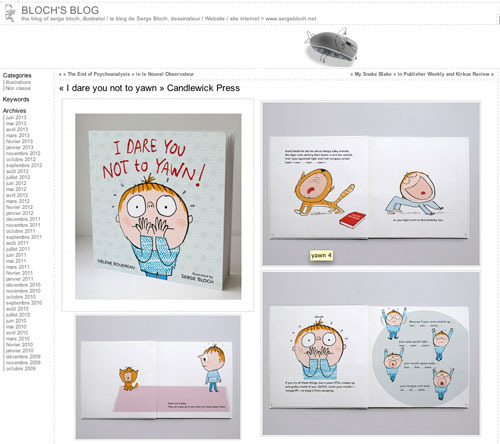 Click image above to visit illustrator's blog post about I DARE YOU NOT TO YAWN
Click image above to visit illustrator's blog post about I DARE YOU NOT TO YAWN
Serge shows a couple of spreads of his illustrations based on the breakdown of my text. In some spreads like (spread 1/ page 4-5) the text only happens on one page, though the art spreads across two. In another, like (spread 2/ page 6-7) the text and pictures are broken up into two distinct entities, and finally in (spread 8/ page 18-19) both the text and the pictures flow over the two pages.
When submitting my manuscript to my editor, though, I don’t use the table since it makes it hard for her to make editorial comments. I format my text like a typical manuscript and label each spread with headings so she can visualize the page breaks. Example:
Spread 1 (page 4-5)
Text, text, text…
Spread 2 (page 5-6)
Text, text, text…
and so on until
Spread 15 (page 32)
Text, text, text…
I keep my ‘illustration notes' as sidebar ‘comments’ or numbered footnotes so they don't clutter the text.
IMPORTANT: be mindful to only add illustration notes when absolutely necessary (ie when the text has a double meaning, which is not obvious, frex).
Complete! Now that I’ve worked on my text and have revised it within an inch of its life, it’s the time to show my work to a few trusted critique friends, my kids, my husband, my agent and whomever else will be gracious enough to read my story. This is the time I’m most possessive of my words—like showing off your newborn baby to the world and daring anyone to tell you it’s not the most beautiful creature they’ve ever seen. But, of course, I need to get over myself and allow the story to be vulnerable for a while. This is the final step before I send my story to my editor so I want it to be the best I can make it. Do I pout? Lots! But it’s for the greater good and I work on my story for a few more months in this manner.
Finally, it’s time to share my manuscript with my editor. By now, I Dare You Not to Yawn had taken about a year and a half to write and revise in its various iterations. I had shared it with at least a dozen people so I had a lot of opportunity for feedback. You would think, at this point, that the story was pretty much ready to send to the printing press, right?
Not so fast, cowgirl.
Before acquiring the project, my editor and I did a pretty intense round of revisions. I worked for weeks to get it perfect then sent it off again, hoping I’d struck the right chord. I must have done something right(ish) because a few days later my agent called with the news that Candlewick would, indeed, like to publish I Dare You Not to Yawn. That was in Fall 2009.
*cue 76 trombones in a big parade*
Can I haz a picture book published now, plz?
Nuh-uh, hold your horses sum’more!
It actually took 18 more months and 6 major revisions for my editor and I to get the text in shape enough so that Serge Bloch could get started on illustrations. Bless my editor’s heart—she was SO patient with me as we worked on draft after draft (after draft). There were times when I honestly thought I should give back my advance money and call it a draw. But I tried to put my trust in the editorial process and we persisted until I heard the precious words; “It’s ready!”.
And as a special treat (or possibly an exercise to discourage anyone from attempting to publish a picture book, like EVER), my editor has given me permission to share the evolution of that text with you here. The following is the step-by-step process (with some, but not all, of the line edit comments and her general editorial comments as footnotes) of how the text changed over that period of a year and a half. There were still a few tweaks after this once we had the context of Serge’s illustrations but you get the picture.
PDF: Evolution of I DARE YOU NOT TO YAWN over six drafts (124k)
In total, from editorial acquisition in fall of 2009 to revisions and illustration to publication in spring of 2013, it was nearly a four year process.
Was it worth it? Totally!
But, hopefully, now you can understand why it took me longer to write, revise, and publish this 400-word picture book compared to my 50,000 word Real Mermaids novels. *wink*
Q. What advice do you have for aspiring picture book writers?
No matter how good you think your idea is—the next one could be better.
It is so important to be constantly generating ideas as a picture book author because, for example, of the thirty or so picture book manuscripts I have in various stages of development on my hard drive, only two (so far) have been actually published. Those are not great odds but the more you create the better chance you have of success. I often see authors fall in love with ONE idea and work and work and work on that idea at the expense of creating new stories. I admire their tenacity but it might not be the best approach at hitting on not only a good idea but a marketable idea. I try to think of those other 28 ideas on my hard drives as prototypes. Good but not GREAT. Keep it fresh and keep it moving, people!
No matter how good you think your book is—it can be better.
There are so many things authors can do to raise their game. My writing improved by leaps and bounds when I joined a critique group. Revision, revision, revision! It’s the process of sculpting away the excess clay to reveal your masterpiece inside. In my case, though, I can only take my story to a certain point on my own (maybe the ‘good’ point?) but need objective feedback to help take things from ‘good’ to ‘great’. Reading many, many, many books in the picture book genre to get a sense of how the pros do it and reading books on ‘craft’ can be useful as well. Going to conferences, reading articles and joining professional author associations are a wealth of information as well.
It’s not one thing, it’s everything.
No matter how unfair and just-plain-wrong the comments from your critique partner/agent/ editor seem to be—there is usually truth in every critique. It’s your job to pull out the ‘why’ of their reactions.
This can be so frustrating. Just recently, my agent critiqued a picture book manuscript of mine and while she loved the overall concept she thought my ‘punch line’ in spread #13 could use more punch and she gave me a potential example of how I could spice things up. “Are you kidding me?” was my first response, “my idea is MUCH more brilliant! Why can’t she see that??”. (LOL, sorry super agent, Lauren…)
So, I sulked for a while (three weeks, to be exact), asked two other people for their advice in the meantime (one who agreed with her, which made me sulk even more) then got over myself and tried to look at my agent’s comments in a less egotistical/prima donna manner. Now, finally, I am realizing that even though my agent had given me an example of how the story could be better, that was merely a jumping off point for me to push myself and get the story to the next level.
Was she right after all? Begrudgingly, yes. There is a problem with the punch line. My agent was merely pointing that out. Now, it’s my job to figure out how to fix it.
Q. What are you working on now? Any other upcoming events or other info you'd like to share?
At this very moment, I’m working on revisions for the fourth book in the Real Mermaids series. I’m also working on a new picture book, which I hope will be a companion picture book to I Dare You Not to Yawn but that remains to be seen—if only I can sort out spread #13!
You can connect with Hélène at her website, on Twitter, Facebook and Goodreads.
---------------------------------
For more interviews, see my Inkygirl Interview Archive.







June 8, 2013
Monsters, Picture Books and Creative Process: Author Tara Lazar & Illustrator James Burks re: THE MONSTORE (Aladdin)
 I first became familiar with Tara Lazar through her wonderful blog, Writing For Kids (While Raising Them) and her PiBoIdMo (Picture Book Idea Month). Tara's debut picture book, THE MONSTORE, is written by Tara and illustrated by James Burks, and just came out from Aladdin.
I first became familiar with Tara Lazar through her wonderful blog, Writing For Kids (While Raising Them) and her PiBoIdMo (Picture Book Idea Month). Tara's debut picture book, THE MONSTORE, is written by Tara and illustrated by James Burks, and just came out from Aladdin.
Basic story premise: Zach buys Manfred The Monster from The Monstore to keep his little sister from snooping in his bedroom, but his plan backfires as Gracie teams up with Manfred. Zach goes back to The Monstore (no refunds or exchanges) for another monster...and another...and another. I won't give away the fun surprise ending; you'll have to get your own copy to see. I love the bright colors and scary-cute monsters, and Gracie is awesome.
 Tara's upcoming books include I THOUGHT THIS WAS A BEAR BOOK(illustrator: Benji Davies, Aladdin/Simon & Schuster, 2014) and LITTLE RED GLIDING HOOD (illustrator tba, Random House Children's). More info about Tara and her books on her website at TaraLazar.com, and you can also find her on Twitter and Facebook.
Tara's upcoming books include I THOUGHT THIS WAS A BEAR BOOK(illustrator: Benji Davies, Aladdin/Simon & Schuster, 2014) and LITTLE RED GLIDING HOOD (illustrator tba, Random House Children's). More info about Tara and her books on her website at TaraLazar.com, and you can also find her on Twitter and Facebook.
This post was originally an author interview, but then James was kind enough to answer a few questions about THE MONSTORE as well; you can find his answers after Tara's. James is the author and illustrator of BIRD & SQUIRREL ON THE RUN (Scholastic/Graphix), BEEP AND BAH (Carolrhoda) and GABBY & GATOR (Yen Press). You can find more about James Burks and his projects at his website.
QUESTIONS FOR TARA LAZAR:
Q. Do you have a writing process? What was your process for THE MONSTORE?
My writing process is to have no process. Seriously. I abhor routine and find that taking the same approach for every manuscript stifles my creativity. Sometimes an idea bursts into my brain and I cannot stop it, it's like a runaway shopping cart. I must sit down and write and let it flow without my internal editor saying "STOP. WAIT. I DON'T LIKE THIS SENTENCE." I can figure it all out later; this concept cannot wait! Yet other times, I get a glimmer of an idea, just a faint sparkle, and I write it down to save for later.
The concept needs to "marinate" like a chewy flank steak. I'd like to say I have an idea notebook that I carefully organize and categorize, but the honest truth is sometimes I write an idea on the back of the electric bill, on my daughter’s Kindergarten artwork, or an old, crumpled Panera receipt. The best part about this is finding that scrap weeks or months later and going YES! I CAN WRITE THIS NOW!
I don't have any rituals, either. Some days I write from a breakfast tray on my unmade bed. Others, I write at my too-small kitchen table. When it's nice out, I go on the backyard deck. Sometimes I write first thing in the morning. Sometimes I write after everyone has gone to bed. Some days I write 5 words and erase 3. And I call that a very productive day.
I do a lot of staring. One day my husband came into the bedroom where I was working. He asked me a question, but I didn't respond. It didn't register; I was so deep into my manuscript. He finally asked, "Oh, are you writing?" I answered yes. "But you aren't typing." I laughed. "I'm staring," I explained. "Staring is writing." I stare a lot. The most time-consuming part of writing a picture book is the staring. (OK, you can call it thinking.)
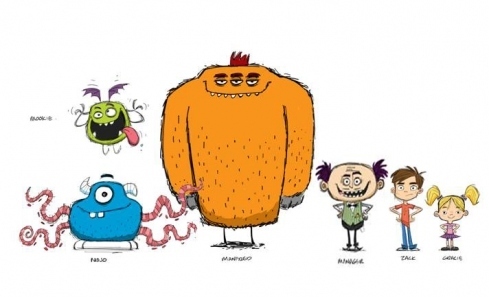 Some characters from THE MONSTORE. Art ©2013 James Burks.
Some characters from THE MONSTORE. Art ©2013 James Burks.
THE MONSTORE began with just a title. That's it. I thought it was a clever play on words. But I had no story to go with it. I carried the title in my brain for months. It would pop out at inconvenient moments, like at the checkout line at the grocery store. It would ask, "Hey, Tara. When are you going to take me for a ride?!" I thought the pineapple was talking to me. And I told the pineapple it was getting pushed in the cart and to keep quiet, there was Kardashian gossip to read.
[image error]Then I attended the NJ-SCBWI conference in 2009 and met an agent I had known from social media. She asked what I was working on--the question every writer hopes for--and I didn't have a good answer. I asked if I could send her a list of picture book concepts to see what would be the best ones to pursue. She agreed. And I had nothing to send!
So I quickly came up with a premise for THE MONSTORE: a boy wants to return the monster he bought because it doesn't spook his little sister. The agent told me to run with it. So I tossed out the pineapple, shoved THE MONSTORE into the shopping cart, and away we coasted! The story spilled out quickly and my critique partner, author Corey Rosen Schwartz, said "This will sell!" I was submission-shy at that point, having racked up a pile of rejections, so I sat on the story for months.
 Tara's workspace. "There is my husband, my tea, my lunch and a stack of books...my unmade bed workspace!"
Tara's workspace. "There is my husband, my tea, my lunch and a stack of books...my unmade bed workspace!"
I submitted it to another NJ-SCBWI event, but I couldn’t attend because I had become ill with Multiple Sclerosis. It was a really bad time for me. I was bedridden and depressed. But the organizer of the event said she would have the editor mail her critique to me. When it arrived, the envelope was so fat, I assumed it was crammed with all the things the editor hated, so I ignored it. I let it sit on the kitchen counter for a couple weeks.
When I finally got the nerve to open the letter, I read the first sentence and couldn’t believe it: “What a fun story with a clever premise. I was hooked on page one.” The letter was filled with complimentary bullet points with suggestions for revision and an invitation to submit. That’s when I knew I had something special and I began querying agents. Soon thereafter I signed with Ammi-Joan Paquette of the Erin Murphy Literary Agency and about four weeks later, the manuscript sold to Aladdin. It happened very quickly. And it has never happened that quickly ever again!
THE MONSTORE went through two rounds of revisions with my editor Alyson Heller, and I’m so glad it did. It was a good story when I submitted it, but it was a great story when we were finished with the revisions!
 Sample image from THE MONSTORE. Art ©2013 James Burks.
Sample image from THE MONSTORE. Art ©2013 James Burks.
Q. What advice do you have for aspiring picture book writers?
The best advice I have for aspiring picture book writers is something I wish I would had been told a long time ago. Good writing isn’t enough. You need a killer concept.
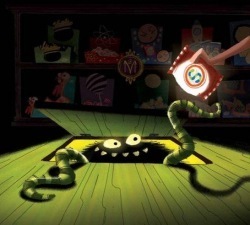 Sample image from THE MONSTORE. Art ©2013 James Burks.A well-written story with a mediocre concept will get a form rejection every time. But a fresh, unique concept that needs better execution will get a revision request. And a killer concept that’s written well? That’s your ticket to a contract.
Sample image from THE MONSTORE. Art ©2013 James Burks.A well-written story with a mediocre concept will get a form rejection every time. But a fresh, unique concept that needs better execution will get a revision request. And a killer concept that’s written well? That’s your ticket to a contract.
I critique a lot of manuscripts from new writers and that’s my most common suggestion—to work on the concept. Because there are a lot of very good writers who understand the structure of a picture book story, but they write about too-common themes and are almost always pushing a message. Don’t think about delivering a message. Think about entertaining kids.
You hear a lot of talk lately about writing character-driven manuscripts, and that’s good advice. The better advice? Write fun-driven manuscripts. Does a kid want to be taught to eat their spinach and to say please and thank you in a book? Nah. They hear that from their parents, their teachers and their Sunday school. EVERY DAY. Let books be their escape, not yet another place to teach. Go for the fun. You’ll be fostering a life-long love of reading.
Q. Any tips for picture book authors looking for agents?
For PB writers seeking an agent, I suggest having at least 3-5 manuscripts ready to go. The more the better; the more polished the better. Don't query with one or two--because that agent is going to want to see more of your work, I guarantee! Picture books are a difficult sell, and overall they make less money than a novel, so an agent wants to see that you have a body of work they can submit and sell. The best thing to do is to wait and not query too early--because if you query too early, before your manuscripts are ready, you've lost the chance to query that same agent with the same work at a later date. I know this means waiting years--but I don't like to use the term "waiting". It means WORKING years. And it will all be worth it, trust me.

I've also seen new writers make the mistake of querying agents AND editors at the same time. Do not do this if you're intent on getting an agent! If an agent learns the project they love has already been shopped widely and rejected, they'll assume they won't be able to sell it. And you'll lose an agent opportunity.
While you can sell a manuscript on your own, I believe the best bet for new writers is to get an agent. More and more houses are closing to unsolicited submissions. I would never have gotten a deal with Aladdin/Simon & Schuster without my agent, Ammi-Joan Paquette.
I didn't really query Joan--I received referrals from two friends and just sent the full manuscript of THE MONSTORE. She loved it and asked to see more of my work. I then submitted two more PB manuscripts and the first chapter of a MG novel. She liked it all! I had queried other agents who only liked THE MONSTORE and some of my ideas (which weren't manuscripts yet), so I knew Joan, who was excited about it all, would be the right agent for me. We've sold three picture book projects together in three years (plus one YA essay), all during my "without a release" phase...with a few more on the horizon...I hope...!
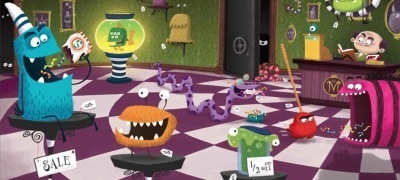 Sample image from THE MONSTORE. Art ©2013 James Burks.
Sample image from THE MONSTORE. Art ©2013 James Burks.
Q. What are you working on now? Any other upcoming events or other info you'd like to share?
Oh my, I think the question is what I am NOT working on now! I sometimes have too many ideas, and that’s what I’m dealing with right now. I’ve had some new manuscripts get rejected recently, but rejected from “fans” who make suggestions for improvement, so I’m eager to revise and get it back to them. And there’s other ideas just begging for me to get started on them. There’s only so much time in a day, and I find that by the time I drop off my kids at school, it’s already time to pick them up again. My days fly by. I am not a morning person, but now I am waking up early on weekends just so I have uninterrupted time to work. Err, I mean stare.
QUESTIONS FOR JAMES:
Note from Debbie: I also asked James Burks about what it was like illustrating THE MONSTORE, and here are his responses.
 Photo from James Burks website.
Photo from James Burks website.
Q. What was it like to illustrate THE MONSTORE?
Working on the Monstore was fun. It pushed me to develop a new style that I thought was more "picture-booky." It was a bit more painterly. A bit of a departure from my other style which has more of a comic book feel.
 Image © James Burks.Q. What was your process?
Image © James Burks.Q. What was your process?
I tend to work in Photoshop and draw on a Cintiq monitor with the exception of my initial sketches which I drew in my sketchbook. I wanted the colors to be a bit brighter, especially for the monsters.
I drew inspiration from the Haunted Mansion at Disneyland for the interior of the Monstore. I wanted it to be victorian and old and a bit gaudy with gold ornate frames. I like to give layers to my illustrations so that there are lots of things to look at. The reader might spot things that they didn't see on the first read.
Q. How did you start working with Aladdin/S&S?
Working with Simon and Schuster was great as well. They had contacted me after seeing something on my website that caught their eye. I was excited to take on a project that featured monsters and thought the concept was great.
All in all, I'm super happy with the way the book turned out. It is definitely some of my best work to date and I hope that everyone enjoys reading it as much as I enjoyed illustrating it.
------------------------
For other interviews, see my Inkygirl Interview Archives.







June 7, 2013
MicroBookTweet: BETTER NATE THAN EVER by Tim Federle
Finished BETTER NATE THAN EVER by @timfederle. Hilarious, smart writing w/emotional depth. I am utterly charmed by Nate.
— Debbie Ridpath Ohi (@inkyelbows) June 7, 2013
More info about Tim Federle: http://www.timfederle.com/
On Twitter: @TimFederle
Click on my "microbooktweet" tag to browse some of my other micro-length book reviews and tweets.







June 6, 2013
John Green Defends Traditional Booksellers, Publishers and Editors
Love this.
p.s. Warning: some of the language is not appropriate for younger listeners.
(Thanks to Teleread for the link.)







June 5, 2013
And the Golden Marmot goes to: John Hendrix @hendrixart
This week's incredibly prestigious Golden Marmot award goes to illustrator John Hendrix for his brilliant Twitter profile bio above. You can find out more about John at Johnhendrix.com and on Twitter at @hendrixart.







Seattle Public Library sets world record for longest book domino chain
After seven hours and five attempts, volunteers from the Seattle Public Library and local residents set up a total of 2,131 books to break the world record for the longest book domino chain. The event kicked off the library's Summer Reading Program.
Thanks to the Seattle Public Library, Book Patrol and King5.com for the info.)







May 30, 2013
MicroBookTweet: RATS SAW GOD by Rob Thomas
Finished/loved YA story RATS SAW GOD by Veronica Mars creator @robthomas. Laugh-out-loud funny, smart, honest, irreverent.
— Debbie Ridpath Ohi (@inkyelbows) May 28, 2013
Click on my "microbooktweet" tag to browse some of my other micro-length book reviews and tweets.







May 24, 2013
Interview with Literary Agent Emily Keyes of L. Perkins Agency (and my 25,000th follower!)
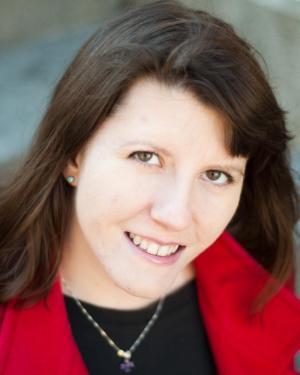 Thanks so much to Emily Keyes, the 25,000th person to follow me on Twitter. Emily is a literary agent at L. Perkins Agency, and kindly agreed to answer a few questions for Inkygirl readers about her work and what she's looking for.
Thanks so much to Emily Keyes, the 25,000th person to follow me on Twitter. Emily is a literary agent at L. Perkins Agency, and kindly agreed to answer a few questions for Inkygirl readers about her work and what she's looking for.
Q. How did you come to work at L. Perkins Agency?
Lori Perkins, the founder of the agency, used to teach at the NYU and I was a student at the NYU Publishing Program. She was looking for interns and I worked for her briefly, going through slush, but she kept in touch with me when I was working other places.
So when my job at Simon & Schuster ended, she said I could come work for her which was huge for me because I was really worried about what I was going to do, and because I had always been very interested in the agent-side of the business. In addition to building up my own list, I do the contracts and foreign rights for the agency.
Q. Are you open to submissions? If so, what kinds of books are you looking for? What are you NOT looking?
Yes, I am open to submissions. I'm looking for all kinds of things. I still feel like I'm really building my list. I'd really like to see some middle grade novels from your readers. I get a lot of teen books but not as many younger readers. I'm not looking for picture books right now though. I love them so much, but I worry about my grasp on the market. Maybe one day. I'm also not looking for erotica. I get a lot of erotica submissions which is awkward.
(Note from Debbie: Emily does not currently represent illustrators.)
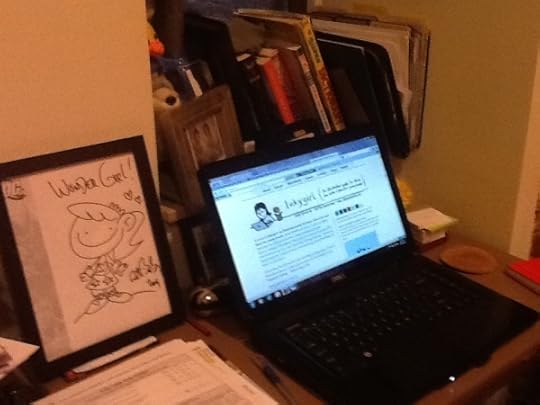
Q. You mention you're especially looking for middle grade novels. Any specific types/genres you're looking for? e.g. fantasy vs contemporary, etc. Any examples of MG novels you especially like?
I love a lot of types of middle grade. I wouldn't say no to fantasy, but I'm leaning toward contemporary these days. Or science fiction. I think there are a lot of MG fantasy books out there already, so the bar is set very high. My favorite MG growing up was probably MATILDA and I can't wait to see the musical. I recently read ZEBRA FOREST and enjoyed that quite a bit. And THE ONE AND ONLY IVAN made me cry a lot (I have a thing about baby elephants, in that I love them).
Q. How should writers submit material to you?
Authors can send their query and the first five pages of their manuscript (pasted into the body of the email) to emily at lperkinsagency dot com.
Q. Who are some of your clients? Any new or upcoming projects you'd like to mention?
My client Sara V. Olds has a book called MY LIFE AS A LUMBERJACK coming out on May 30th. Definitely check it out if you're interested in a fun summer read. Some of my clients are Kit Forbes (who used to write adult romance novels under the pen name Barbara Sheridan, her first YA is coming out next year), Kenneth G. Bennett (who self-published his middle grade series and we recently sold the film rights, that's exciting), Amy Zhang (who wrote a piece for CHICKEN SOUP FOR THE SOUL: INSPIRATION FOR WRITERS that came out May 21) and Dale Lucas (whose YA science fiction story recently appeared in the FUTUREDAZE anthology). I also have some exciting things that are going to be announced soon that I'm dying to talk about but can't.
 At the Paris bookstore, Shakespeare and Co.
At the Paris bookstore, Shakespeare and Co.
Q. What advice do you have for aspiring children's/YA book writers?
Read a lot. Your followers probably don't need to be told this, but I see a lot of submissions from people who don't actually read kidlit. They just think, "Hey JK Rowling made more money than the Queen! It's easy!" I find that very insulting. Writing for kids is so much fun, but it's also a lot of work. I think the shorter the book, the more each word matters, so the degree of difficulty actually goes up.
Q. Where can people find out more about you online?
I have so many online accounts. I tweet almost every day at @esc_key. I also have a blog and a tumblr. Those are the three I use professionally. I'm still trying to figure out what to post where. But I do like interacting with people, especially readers.
Q. Anything else you'd like Inkygirl readers to know?
I used to moderate a blog about Sweet Valley High called 1bruce1. I debated mentioning it in the above question, but it's not professional (at all!). I haven't had much, if any, time to devote to it recently. I guess it says something about me that I work on young adult books all day and then, for fun in my free time, I read more.
The L. Perkins Agency www.lperkinsagency.com
Twitter: @esc_key
-----------------------------
For more interviews, see the Inkygirl Interview Archive.







May 23, 2013
Book-Buying Poll Results: Content is king, whether a book is self-published or not
I had originally intended for this to be a quickie poll in my series of Informal Surveys/Polls About Writing, Reading and Publishing but realized that for a topic like this, there is no such thing as a quickie poll. The topic is clearly a pretty sensitive subject, and some people automatically assumed that I was out to discredit books that had been self-published. Yikes.
For the record, I have bought self-published books. Some were very good (like Cheryl Rainfield's YA novel, Parallel Visions) and some were not so good. I am going to be self-publishing a compilation of my writer comics (my agent at Curtis Brown is helping me with this).
I know there are many out there who sneer at those who self-publish, but I am not one of them. As I said, there are some very excellent self-published books. But there are also many, many bad self-published books. Overcoming that stigma will be a challenge for indie authors until there are easier and better-known ways to separate the good from the bad.
The "Us vs. them" hostility (on both sides of the equation) frustrates me. It's not productive, it sparks flamewars, it only widens the gap between those who publishing with traditional houses and those who go the indie route. The truth is that more writers are starting to experiment with doing both. It's a choice.
And whether you choose to go indie or traditional with any particular book, your focus should always be on quality content. There are many good resources online to help; please feel free to post suggestions below. NOTE: I will note tolerate flamewars in the comments section so if you post a hostile or abusive message, whether pro- or anti- indie publishing, I WILL REMOVE IT/NOT APPROVE IT FOR POSTING.
But on to the poll results....
I knew when I posted the poll that the results would probably skew toward those who already had an interest in self-publishing (whether positive or negative). However, I was mainly curious about the people who bought a book they knew was self-published (and DIDN'T know the author/illustrator), and why they did so....I figured the results would give some useful info about book discovery, and that info could help indie authors.
However, some pointed out that some self-published books out there that don't LOOK self-published, so how would people KNOW if they had bought a self-published book? Also, some pointed out my poll answer choices didn't cover the scenario where a traditionally published author decided to go the self-publishing route. I'm sure there were many other situations that my limited yes/no type of choices didn't cover.
With the above in mind, here are the results of my poll:
141 people participated in the poll and of these, 78% said they had bought a self-published book.
Of those who bought a self-published book, 42.5% said they made the purchase because they knew the author and/or illustrator, and wanted to support them.
I was mainly interested in the remaining 57.5%, who had bought a book but weren't familiar with the author and/or illustrator, or said that knowing the author and/or illustrator was a factor in their purchase decision.
Of these purchases:
67.7% were digital, 27.7% were print and 3.1% were digital AND print. One person wasn't sure.
The most interesting part of the results, at least for me, were the reasons that people bought these books. Here are some of the reasons:
37.5% -- Word-of-mouth recommendations
31.3 % -- A review
20.4% -- The book was $2.99 or less.
10.9% -- The cover.
9.4% -- The book was free, so they figured they had nothing to lose.
Other reasons listed in the open-ended comments section, from most popular:
Liked the sample excerpt.
Non-fiction book about a unique topic.
Fan of the author. Author had traditionally published in the past but had decided to self-publish a new book or a sequel to a traditionally published series.
Story description or blurb intrigued them.
Amazon suggestion based on other books they had bought.
Fan of the author's blog.
Met the author in person or saw their presentation at a convention/in-store event.
Book recommended by publication or blog.
Book was subject of a controversy.
SUMMARY:
By far, most of the people who commented said that their book purchase decision was made because they liked the sample excerpt.
Second-most common reason: because the book offered them content they couldn't easily get elsewhere...in nonfiction, this involved a niche topic. In fiction, it was because an author they liked was offering more of his or her writing.
So in the end, people don't really care whether a book is self-published or not. What matters: quality content.
-------------
Also see my other Inkygirl Surveys and Polls about reading, writing and publishing.







May 20, 2013
Interview with Celia Lee, Assistant Editor At Cartwheel Books (Scholastic), open to unagented submissions from Inkygirl readers for limited time
 Celia Lee is an assistant editor at Cartwheel Books, Scholastic’s 0-5 imprint. When she’s not reading, she’s talking about reading. And when she’s not talking about reading, she’s thinking about reading. You can follow her on Twitter @VitellusD.
Celia Lee is an assistant editor at Cartwheel Books, Scholastic’s 0-5 imprint. When she’s not reading, she’s talking about reading. And when she’s not talking about reading, she’s thinking about reading. You can follow her on Twitter @VitellusD.
How did you come to work at Scholastic?
So I had been going to grad school (for Publishing) and doing various editorial internships for a few publishers in the city for about a year, when a wonderful, kind, generous classmate of mine told me she was leaving her current Scholastic Book Clubs job for a new position in the company.
This was HUGE news for me, because Scholastic was the first publisher I ever knew about, due in part to the Book Clubs flyers I poured over when I was in elementary school. So being the enterprising individual that I am, I applied and interviewed for the job…which I didn’t get (but a very good friend of mine got it instead, which is a whole other story!).
 Luckily for me, the kind classmate heard about another opening in the Book Clubs division and passed along my resume. Et voila! I got the job, worked for a few years for the wonderful Book Clubs, and then moved over to my current position with Scholastic’s Cartwheel imprint. I guess I’m a Scholastic gal through-and-through.
Luckily for me, the kind classmate heard about another opening in the Book Clubs division and passed along my resume. Et voila! I got the job, worked for a few years for the wonderful Book Clubs, and then moved over to my current position with Scholastic’s Cartwheel imprint. I guess I’m a Scholastic gal through-and-through.
What is your typical work day like?
Mornings are usually the calmest part of the day. That’s when I can write a few emails, organize our imprint’s various internal charts and grids, catch up on the latest children’s book reviews/announcements, look at production passes, and review and respond to submissions. Afternoons are a little busier, because that’s when most of our meetings happen—with production and planning, or editorial and design, or even with our Book Clubs and Book Fairs. But I also squeeze out more emails and work on submissions in-between meetings. So essentially my day consists of writing, whether it be emails, proposals, or copy; reading, either emails, manuscripts, or proofs; and meetings, with anybody and everybody!

What's the best part about your job?
Working with so many talented authors, illustrators, designers, and editors!
What's the most challenging part about your job?
Working with so many talented authors, illustrators, designers, and editors! Seriously, all of these guys are so creative and inspiring—they really challenge me to be the best that I can be. It’s great…and it’s hard work!

Is Scholastic open to unagented submissions from writers and illustrators? If so, could you please give us more details?
Scholastic’s current policy is that we are not accepting unagented submissions. However, our Cartwheel imprint is opening up a 2-month window starting today, where we will review unagented submissions. (Note from Debbie: This means that your submission must arrive at the address below by Fri July 19th, 2013.)
If you have a submission geared for 0-5 year-olds (board book, novelty, or picture book), we’d love to take a look!
Please snail mail your manuscript to:
Scholastic Inc.
Attention: Cartwheel Inkygirl Submissions
557 Broadway
New York, NY 10012
Scholastic Inc.
Please include a SASE if you would like your submission returned.
Note from Debbie: I asked Celia if she'd be the person who would be reviewing submissions and what kind of submissions was she especially looking for/not looking for, plus if she was open to submissions from illustrators who are NOT writers. Celia says that she'll be the primary reviewer though other editors may also take a look. From Celia:
"In terms of what we’re on the lookout for: holiday; tried-and-true subjects like transportation, community, or new experiences; interesting novelty formats; and new ways of addressing core concepts. Things that we’re not looking for are nonfiction, anything older than 1st Grade, and “love” books. And we can certainly take a look at illustrators who aren’t writers! They can send a postcard with their url to their portfolio."
What advice do you have for aspiring children's book writers and illustrators?
Really explore the book market out there. Go to your local bookstore or a Barnes and Noble and see the kind of books that they display. Then go to stores that have a book section—your Targets, your Walmarts, even your Gaps and Anthropologies. An understanding of what booksellers of all kinds are selling out in the world is invaluable, and can really help you market your stories to publishers.
Related online resources:
About Scholastic Children's Books Publishing & Distribution
Also see my other Inkygirl interviews.










